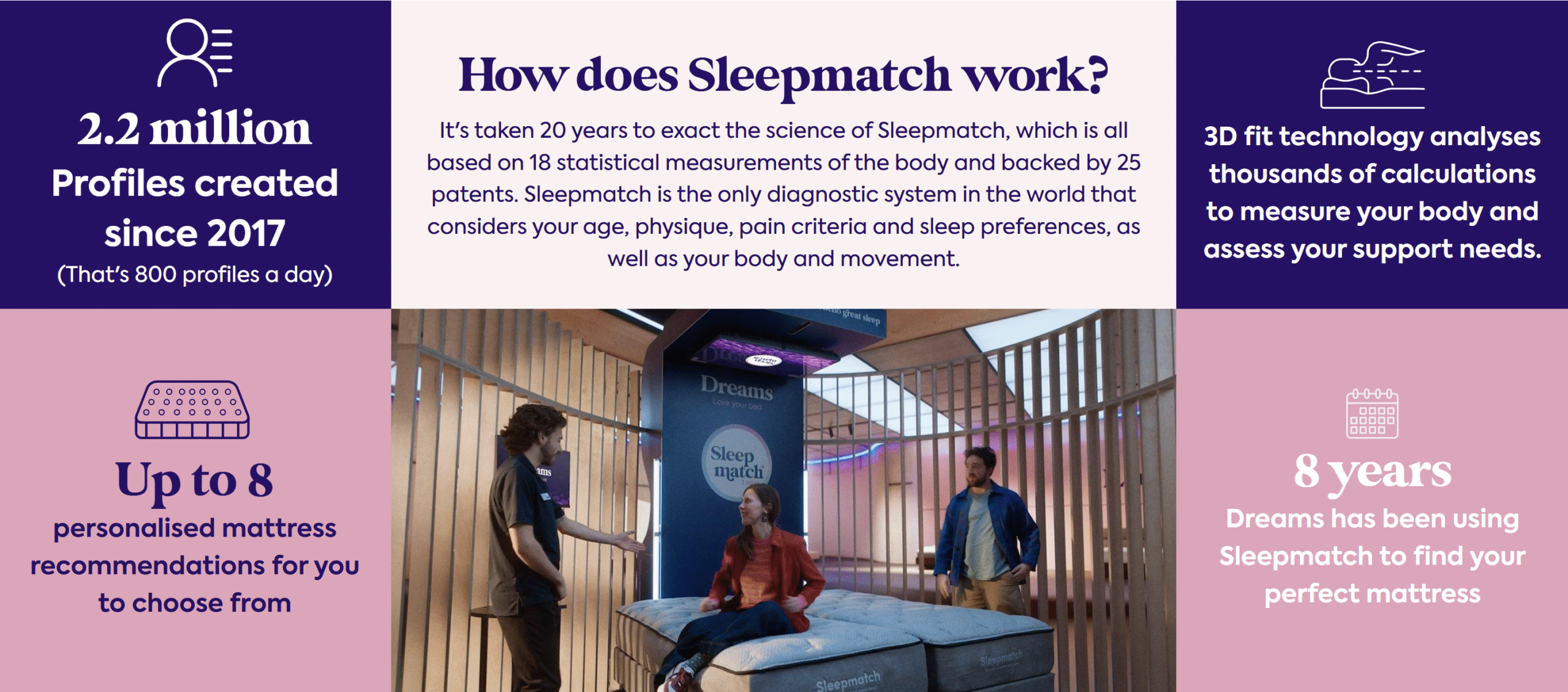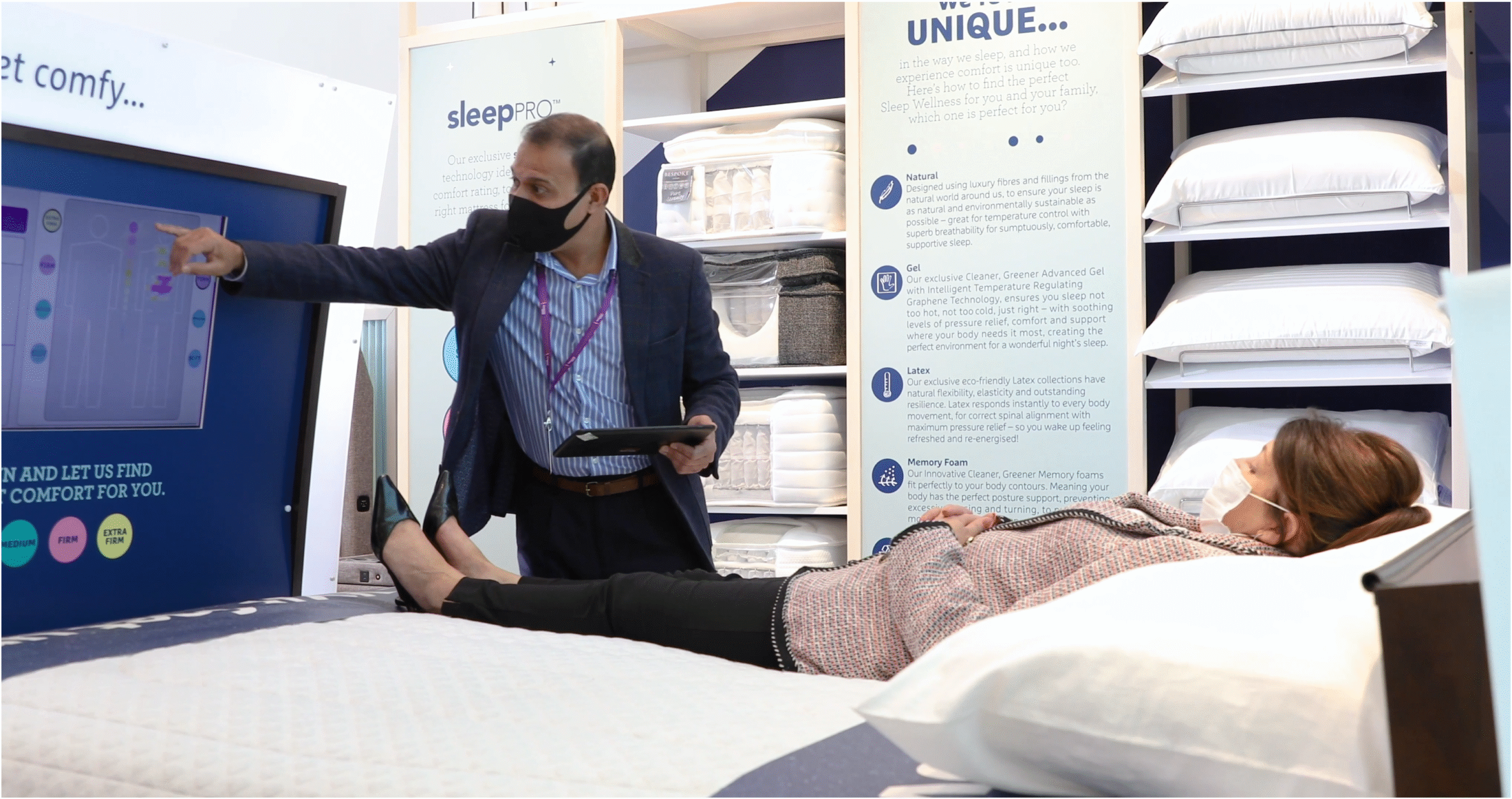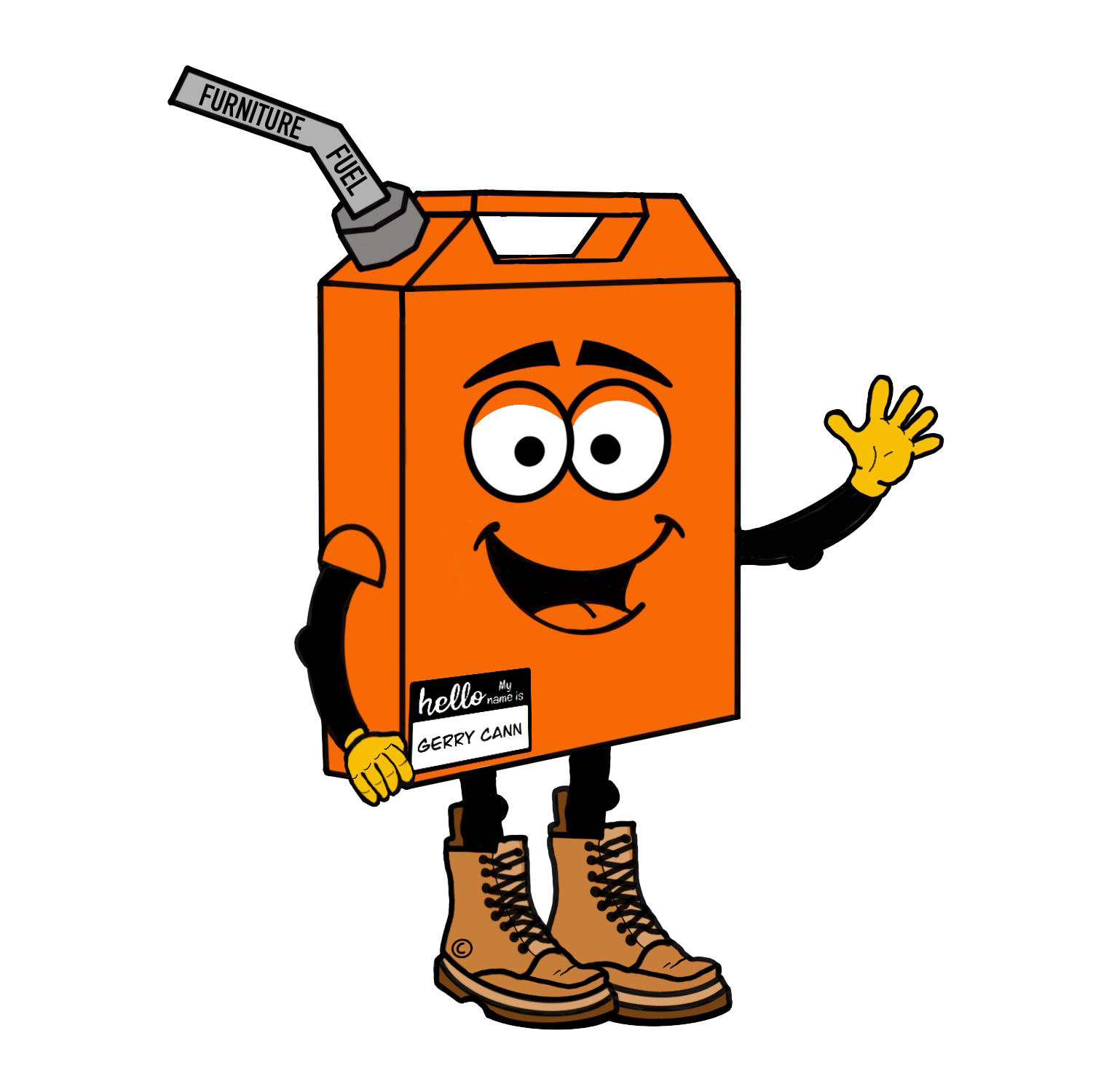The Secret Psychology of How Mattress Finder Machines Built Trust
Jack Young
- Last Updated: 13 September 2025
TL;DR - How Do Mattress Profile Machines Build Trust?
Mattress profiling machines, like those used by Dreams and Bensons for Beds, build trust not through precise science, but by engaging customers psychologically. While they are not flawless scientific devices, and their recommendations can vary, they succeed by creating a perception of objectivity and empowering customers with seemingly unbiased, data-driven insights. This process reduces the built-in mistrust in sales interactions and completely reframes the buying decision. Ultimately, the customer’s role shifts from being sold to, to actively being involved in and co-creating their own solution.
Instead of trying to copy them, independent retailers should look at combating the root issue: information asymmetry. Building trust by arming customers with detailed educational content and personal expertise that a machine can’t replicate.
Trust, not technology, is the ultimate driver of successful mattress sales.
Table of Contents
The Trust Deficit in Furniture Retail
Every new customer to your brick-and-mortar or e-commerce store arrives with a trust deficit. They are instinctively on the defensive.
Where does this distrust come from? Why don’t people presume trustworthiness until proven otherwise?
The world is full of choices—often too many. The brain looks for signals to confirm that this is a good decision or to warn us of risk.
Evolutionary psychology suggests our brains still operate much like they did in the hunter-gatherer era. Today, survival isn’t about avoiding predators, but about protecting our social identity and financial choices. Not buying the “right” trainers may not kill us, but it can still create social costs and regret.
A key driver behind risk and customer hesitation is loss aversion, the behavioural economics principle that losses are felt more intensely than equivalent gains. This means the pain of buying the “wrong” sofa outweighs the joy of getting the perfect one.
Furniture buyers must navigate obscured jargon and material claims while talking with a salesperson they’ve just met. Rather than feeling at ease, they often suspect a bias. The salesperson is trying to get a sale, not help them buy.
This challenge is especially present in mattress buying. Purchasing a mattress involves both financial and health risks. Consumers are often reminded not only of the cost of a poor mattress but also of the consequences of inadequate sleep on well-being. Yet most mattresses, at least visually, resemble commodity products—they look similar, and their quality is difficult to assess before purchase.
Mattress assessment technology reframes the decision process. It reduces the customer’s sense of risk and creates a perception of greater control by providing data-driven insights that make the invisible aspects visible.
But is there a way smaller independent retailers can compete with these expensive machines?
The Mattress Profile Machines
I have heard, both from customers and industry retailers, opinions on these mattress profile machines used by larger retailers such as Dreams and Bensons for Beds.
Customer feedback is generally positive, sometimes overwhelmingly so. The retail side, however, tends to be more sceptical. Typical remarks suggest the machines are made from gaming console parts, or that they’re little more than a gimmick. And I understand that reaction.
These remarks often act as a defence mechanism when retailers are confronted with a tool that customers respond to positively. The instinct is to undermine it, to suggest that it is nothing more than a fairground amusement ride designed to trick you.
But the part that often gets missed is that even if the machine were a kind of Wizard of Oz showpiece—with someone secretly pulling levers behind the curtain—it still works, not because of precise science, but because of the psychology.
The true value of the mattress machine lies not in its medical or engineering accuracy, but in how it creates a perception of objectivity and empowers the customer.
In doing so, it increases transparency and builds trust.

Source: Screenshot taken from Dreams Sleepmatch® page. Available on their website.
Why Do Mattress Testing Machines Build Trust
Both the Bensons for Beds, SleepPRO® and Dreams Sleepmatch® machines achieve two essential things. They reduce the role of the salesperson and actively involve the customer.
Why Removing the Salesperson Builds Trust
I’ve been there. A customer hears a simple “good morning” and immediately thinks, Oh no, what’s their angle? You can’t blame them. The cliché of the sleazy salesperson exists for a reason.
Bad actors have damaged the image of retail, pushing products customers don’t want and credit agreements they don’t fully understand, requiring their firstborn child as payment. Okay—a little dramatic, but you get the point. Customers instinctively view the interaction with suspicion.
At its core, the challenge is trust. The salesperson isn’t seen as a neutral guide but as someone whose advice is motivated by hidden incentives or pressures. Commissions, sales targets, or pressure from the retailer. Principal–Agent Theory helps explain this perception.
The salesperson (agent) acts on behalf of the retailer (principal), yet the salesperson’s incentives don’t always align neatly with either the retailer’s goals or the customer’s best interests. From the customer’s perspective, both parties appear motivated by profit, making any advice feel suspect.
That’s why the mattress machine is powerful. It removes these conflicts at the key decision point, presenting itself as an unbiased third party. Instead of being viewed as an authority figure with an agenda, the salesperson can reposition themselves as a facilitator or support specialist offering help, not pressure.
Why the Mattress Machine Empowers the Customer
Perceived Control and Co-creation
The mattress machine’s psychological power extends beyond its role in sales interactions. By tapping into two key behavioural principles, perceived control and co-creation, it empowers the customer by redefining the entire buying process.
Perceived control is when customers place higher value on a decision if they feel they have control over the outcome. The mattress machine reinforces this by letting them actively participate—lying on the bed, giving feedback, and seeing their input reflected in data. This shifts the authority balance: the choice feels like theirs, not a salesperson’s suggestion.
Co-creation makes the customer a partner in the solution, not a passive subject. By contributing their own body data, they’re co-designing the “perfect recommendation.” This deepens their psychological investment, making them more inclined to trust the result, and ultimately buy the mattress selected with their input.
The Connection Between Customer and Machine

Source: Screenshot taken from Bensons for Beds SleepPro® video. Available on their website.
Both systems have a monitor or TV screen that displays real-time information. However, I prefer the setup of Benson for Beds SleepPro®.
For me, it increases attention and reduces cognitive load by focusing the customer on the conversation and analysis by removing the distractions in the room better than the Dreams Sleepmatch®. Creating a kind of bubble.
The screen amplifies the sense of perceived control and co-creation by letting the customer “see behind the curtain.”
The mattress machine displays data and metrics directly on a screen that the customer can watch. This tangible information serves as an objective justification for their choice. Rather than relying solely on a salesperson’s opinion, the customer sees clear evidence that a particular mattress configuration is best suited to their body.
This taps into another behavioural principle known as the labour illusion.
The labour illusion is the idea that people feel more confident and satisfied with an outcome if they can see the work or effort that went into producing it, even if that effort doesn’t improve the quality of the final result.
The mattress machine is an excellent example. The customer doesn’t just receive a final recommendation—they watch the machine “working.” They see pressure sensors activating, real-time data visualisations, and adjustments being made. This visible “labour” boosts their confidence in the recommendation, making it appear more trustworthy and valuable.
This principle works hand-in-hand with co-creation and perceived control. The customer’s input, combined with the machine’s visible effort, creates a powerful sense of validation and trust.
Extending In-Store Data to Digital Recommendations
The data generated by these machines isn’t limited to the shop floor. By capturing and analysing the insights from thousands of in-store sessions, retailers can identify clear patterns between customer profiles and mattress types. This information can then be used to create highly effective online mattress guides.
For a customer shopping on the website, the guide could ask them to input key information—such as their sleeping position, body shape, and any pain points. Using the data patterns from the in-store reports, the online guide can then recommend a specific mattress with a high degree of confidence. This primes the online customer, giving them a sense of personalised expertise and a data-backed recommendation even before they visit a physical store. It’s a powerful way to build trust and shorten the online purchase cycle.
Cognitive Dissonance Created by Mattress Machines
Cognitive dissonance is the psychological discomfort felt when holding two conflicting beliefs or values at the same time. In this context, it’s the mental conflict a customer experiences when comparing their experience at Dreams or Bensons for Beds with their experience at an independent retailer.
- Belief 1 (from Dreams or Bensons): An unbiased, data-driven process shows that this type of mattress is best for me.
- Belief 2 (from the independent retailer): This salesperson is telling me that this other type of mattress is best for me, but they have no data to back it up.
The customer feels uneasy because these two experiences don’t align. The absence of a “transparent process” at the independent store makes the salesperson’s advice seem less trustworthy. If an independent retailer is lucky enough to get a customer who hasn’t already used a machine, the salesperson has a fighting chance. But having already formed a belief based on the machine’s data, the customer is more likely to dismiss conflicting advice and return to the store that provided the unbiased recommendation—even if the independent retailer’s mattress is objectively higher quality.
The machine has created a strong sense of trust and control that is difficult for competitors to overcome with a traditional sales pitch.
I believe this dilemma ultimately stems from what economists call the problem of lemons.
The Problem of Lemons
At the start, it was noted that trust often begins with a deficit. This can be explained by what economists call the lemon problem. A concept that describes a market where buyers and sellers have unequal information about product quality. The seller knows the true quality, but the buyer does not.
Consider a furniture retailer who understands the mattress inside and out, the foam density, spring quality, and durability. The customer, however, lacks this knowledge. They cannot see inside the mattress and must take the salesperson’s word for it.
This asymmetry of information creates a fundamental trust issue. The customer fears buying a lemon, a product that looks fine but hides flaws. This fear may cause some customers to avoid buying altogether or to pick the cheapest option regardless of quality. Over time, this drives high-quality products out of the market, as customers are unwilling to pay a fair price for what they cannot verify.
The Mattress Machine as a Solution to the Lemon Problem
Mattress machines address this problem by making the invisible aspects of a mattress visible to the customer. This reduces information asymmetry. The salesperson is no longer the only source of information.
This transforms what could be a risky, uncertain purchase into a verified choice. Customers gain confidence that they are buying a peach, not a lemon, empowering them to invest in higher-quality mattresses.
The Real-World "Lemon": Skimpflation and the Erosion of Trust
In a recent article on tariffs, we discussed skimpflation and shrinkflation. These concepts are real-world examples of the lemon problem. Faced with increased costs and market pressures, some retailers respond by reducing product quality to maintain price points.
This creates a market where “things aren’t made like they used to be.” Customers pay the same or similar prices but receive lower-quality goods.
This cycle becomes a self-fulfilling prophecy:
- Customers, unable to verify quality and value, become cautious and seek cheaper alternatives.
- Retailers then feel pressured to cut costs further, leading to more lemons in the market.
The outcome is a broad erosion of trust and an industry-wide race to the bottom on quality.
Don’t get sold a lemon, keep updated with the latest business strategies that work—subscribe now.
The Independent’s Solution — Fighting Fire with Knowledge
For most independent retailers, replicating the advanced mattress-testing technology of larger retailers isn’t a feasible solution. Instead, the answer lies in tackling the root causes of the trust deficit, the lemon problem and information asymmetry, by empowering the customer with knowledge.
The goal is simple: make the customer as informed as the retailer. This is a fundamental case for content creation.
By providing detailed, transparent content, you equip customers with the ultimate tool—the knowledge to make informed decisions on their own terms. This shifts their trust from passive confidence in a machine to active confidence in their own judgment.
So, how do you do it?
Give Them the Knowledge to Question
Educational content is key. This might take the form of a detailed blog post, infographic, or video explaining the inner workings of a mattress. Break down topics like foam types, spring counts, and material durability. This knowledge arms customers with the ability to question the machine, the salesperson, and the product. When empowered to ask, “Why is this foam better for me?” or “What makes this construction more durable?” they put retailers relying on “gimmicks” on the back foot.
Welcome the Questions
Questions aren’t a challenge—they’re an opportunity. Independent retailers who truly know and love their products can turn questions into a powerful trust-building dialogue. A confident, knowledgeable salesperson can provide honest answers that no machine can replicate, forming bonds that turn browsers into buyers. This requires robust, ongoing training to embed product expertise into the business culture.
Provide the Proof
Go beyond digital content by offering tangible proof points in-store that showcase your unique expertise and the quality of your curated selection. While physical demonstrations, like mattress cut-outs, are a good start, they are now widely used by large chains.
Your real advantage is the story behind the product. You can provide proof by sharing why you chose to partner with a specific manufacturer, detailing their construction methods, and explaining the materials and components you’ve vetted. These physical demonstrations, like displaying a cross-section of a foam or spring type, are no longer just a copy of larger retailers’ strategies. They become evidence that your store has done the research and quality control on behalf of the customer, delivering a level of trust that a large machine cannot match.
Focus on the Core Issue, Not the Gimmick
While easier said than done, the core lesson for retailers facing challenges like the mattress machine is to identify the fundamental driver behind a competitor’s strategy. Why are they implementing this? Then, the goal is to find ways to replicate or neutralise its power.
By concentrating on the root issue, the customer’s lack of trust and information asymmetry, you can develop effective countermeasures, such as arming customers with knowledge. This approach should be proactive, not just reactive. By consistently providing transparent, educational content before the customer even needs a new mattress, you build a foundation of trust. This means that when the customer eventually needs a new piece of furniture, they will already see your brand as a trusted authority, making a competitor’s high-tech technology less of a threat.
This approach removes the need to simply “talk down” a competitor’s machine, which often backfires and reinforces perceptions of untrustworthiness. Ultimately, your success will not be measured by the technology you have, but by the level of trust you build with your customer.


